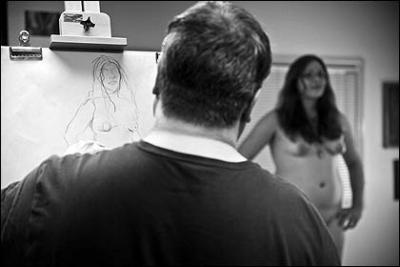
by Caitlin McKimmy
People glance at themselves in windows, take pictures of themselves, and ask each other, “How do I look?” They scrutinize their bodies through a network of literal and figurative mirrors. In a culture that elevates a narrow vision of physical beauty, it can be hard to love the different realities that are reflected — there is pressure from society to mentally paint bodies over with imperfections, and to sketch in innumerable critiques.
But what would happen if you were presented with an image of yourself that was painted or drawn, and infused with the creativity of an artist? Every week at the Eugene Storefront Art Project (ESAP) headquarters, models and their nude bodies become an inspiration for art in organized life-drawing sessions. “It’s easy to take off your clothes as an art form,” ESAP model Meisha Linwood says. “I am always so excited to see people’s talents and how they decide to depict me.”
Linwood, who has been modeling for artists for fifteen years, is an artist herself, and she says she is glad to support the local art community. Lindwood says modeling is a fulfilling form of personal expression. “The body is a beautiful machine,” she says. “I’m no skinny-mini, but I’m definitely comfortable in my skin and I love sharing that.”
At ESAP, life-drawing sessions begin with short, expressive one-minute poses. As the session progresses, models work up to poses that last half an hour. This requires a lot of concentration and strength. “I have to be judicious about choosing models,” Nicola Noetic, the facilitator of the ESAP drawing sessions, says. “I’ve had people that just can’t stay still and keep laughing and moving their heads. That makes it really hard for the artists.”
Life drawing, or figure drawing, is a historically engrained tradition in studio art. Observing a live model, artists wrestle with the intricate contours of the body. “It’s important to use live models because they are three dimensional,” Noetic says. “Every artist has a slightly different perspective of the model. It’s better than drawing from pictures because photographs distort everything a little bit.”
The ESAP drawing sessions have male and female models of all body types. “You have to be really brave to go up there and model,” says Noetic. She has coordinated modeling sessions at several venues in Eugene, and she says that she loves seeing how life drawing bolsters the confidence of artists and models alike.
During these life-drawing sessions, models sink into their skin and artists try to reflect the perfection of the human form. Through this process models and artists alike can’t help but realize that every body is literally a work of art.
The life drawing sessions take place at the ESAP headquarters on E. 11th every Tuesday from 6 to 8 pm. For more information, visit ESAP’s website at www.eugenestorefrontartproject.org/